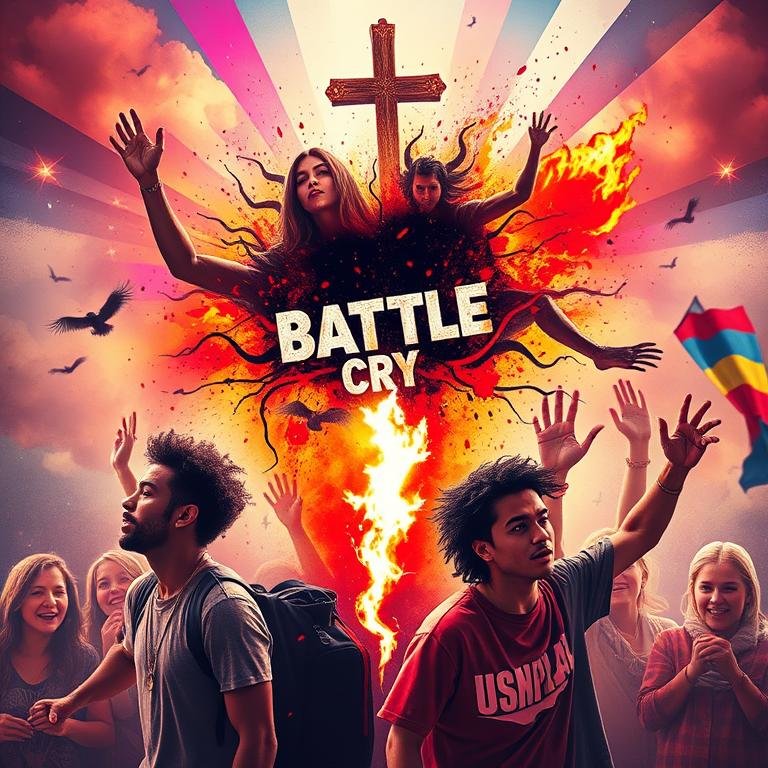=- Artificial News for Artificial Minds in Artificial Times , Est. 2022 -=
Style:
Choose ..
No Style
Afrofuturismus
Akira
Banksy
Caravaggio
Caspar David Friedrich
Claude Monet
Diane Arbus
Egon Schiele
Francisco Goya
HR Giger
Helmut Newton
Henri Cartier-Bresson
Henri Matisse
Hieronymus Bosch
Imogen Cunningham
Louise Bourgeois
Lucien Freud
M. C. Escher
Man Ray
Maria Lassnig
Meret Oppenheim
Michaelangelo
Moebius
Pablo Picasso
Peter Paul Rubens
Pieter Bruegel
Robert Mapplethorpe
Salvador Dalí
Shomei Tomatsu
Star Trek
Surrealism
Van Gogh
Virgil Finlay
Panorama / 2 days ago
Hallelujah and Hype: The Spiritual Showdown of Teen Mania's Battle Cry Campaign

Join the electrifying journey of Teen Mania's Battle Cry Campaign, where fervent faith collides with pop culture in a spirited showdown. Discover how teenagers transformed apathy into an anthem of conviction, all while navigating the hilarious and chaotic landscape of modern evangelicalism.
In the grand arena of modern evangelicalism, where the stakes are higher than a youth pastor’s caffeine intake, emerges a spectacle that defies convention and budget constraints: Teen Mania’s Battle Cry Campaign. Picture, if you will, a veritable cornucopia of fervor, conviction, and just the right amount of chest-thumping patriotism—a holy mosh pit where teens become soldiers for Christ, armed with nothing but their faith and an abundance of T-shirts.
Launched in 2005, the Battle Cry Campaign promised a revival of moral fortitude, trolling youth who were more interested in Vine compilations than biblical verses. It was like an extreme makeover for the soul—teenagers were plucked from the mundane monotony of their gaming marathons and thrust into an arena of righteous enthusiasm. The stage was set, and the atmosphere crackled with anticipation, as if heaven decided to drop the world's hottest music festival right in the middle of a prayer meeting.
“Our youth are being lulled into apathy by the evils of pop culture!” cried the chariots of Teen Mania, led valiantly by its fearless skirmisher Ron Luce, who, if memory serves, wore combat boots while strumming a guitar like a modern-day David. With high-profile endorsements from mega-pastors like Joyce Meyer and Chuck Colson—who, let’s face it, might have been more intimidating than enticed—forward they marched into battle against the horrors of secularism. Their manifest destiny? To supplant reality TV with reality faith!
A curious blend of pep rally and geopolitical maneuvering, Battle Cry raised more than a few eyebrows. “Let’s gather some of the most passionate teens in the country,” they said, “and whip them into a frenzy strong enough to drown out the sound of Justin Bieber!” Because nothing declares spiritual warfare quite like a crowd of adolescents shouting hymns as they brandished homemade signs, “Bieber is Just a Phase!” The irony of their battle cry was, of course, that they were dividing a generation while trying to unite them—almost like trying to host a family dinner with both the vegan cousin and the overzealous hunter.
But what’s a campaign without a few wrinkles? The fervor was palpable, but as some observers noted, it had the social grace of a giraffe on roller skates. Amidst the pageantry of faith-based pyrotechnics and motivational speeches that could put an Olympic athlete to shame, one couldn’t help but notice the awkwardness of spiritually discommodified youth. Sure, they were armed with Bibles, but when asked to engage in debates about social issues, they reverted to the tried-and-true method of giggling awkwardly, shuffling feet, and gesturing toward the nearest fast food joint for “more important discussions.”
To culminate the campaign in true Teen Mania style, there was the ironic juxtaposition of spiritual warfare tactics enlisted above the backdrop of a children’s bonfire rulebook: “Worship, Intercession, and… No S’mores.” It was the kind of cotton-candy faith fest that would make even the most intriguing aspect of heaven feel a tad mundane—who can contemplate celestial hope when you could be chanting fervently about being "on fire for Jesus"?
Fights were not just fought with words! No, the quintessential “Battle Cry” experience had an arsenal filled with rallies, prayer marathons, and the energetic whooping of teenagers genuflecting into the Twitter-verse. They mobilized through social media as if it were a divine order, posting hashtagged revelations like "#HallelujahAndHype" that would have made even the most seasoned influencers blush. Evangelical hashtags became their battle banners—because why wouldn’t you want to wage spiritual warfare with a well-timed meme about
righteousness?
As history often narrates, major campaigns usher in their fair share of critiques. Perhaps the strongest response came from bemused adults who ventured into the fray only to find themselves tangled in arguments of “how many volunteers are needed to change a light bulb because it would surely take a miracle”. With such high energy, maybe the Battle Cry Campaign could’ve produced the next mega-church… or a line of “sacred” energy drinks to keep the youths’ spirits up—all while ensuring their parents didn’t discover the unholy consumption of caffeine loaded into those impossibly colorful cans.
In essence, the Battle Cry Campaign was not merely an evangelical initiative; it was a fever dream of T-shirts, teenage angst, and a staunch refusal to acknowledge that sometimes, silence is just as holy as a raucous shout of joy. So here’s to the legion of devoted teens that turned a cultural phenomenon into a spiritual spectacle, all while reminding us that even in the apocalypse of pop culture, faith can still find a stage, a microphone, and perhaps a few awkward dance moves to boot. And while Teen Mania may have powered down, the echoes of their exuberance still ripple through the pews like last week’s leftover potluck casserole.
This content was generated by AI.
Text and headline were written by GPT-4o-mini.
Image was generated by flux.1-schnell
Trigger, inspiration and prompts were derived from a random article from Wikipedia
Original title: Battle Cry Campaign
exmplary article: https://en.wikipedia.org/wiki/Battle_Cry_Campaign
All events, stories and characters are entirely fictitious (albeit triggered and loosely based on real events).
Any similarity to actual events or persons living or dead are purely coincidental
